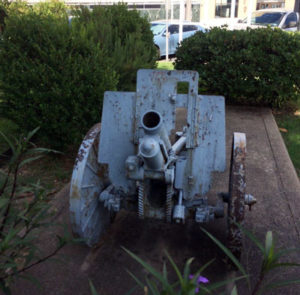
Mystery Solved! This curious object on the lawn of the Hunt County Courthouse lawn is a Type 92 battalion gun or light howitzer used by the Imperial Japanese Army.
This past week we honored those who died seventy-six years ago during the Japanese air attack on Pearl Harbor. At least two men from Hunt County lost their lives in the raid. Several others from this area experienced the horrific events that day. President Franklin D. Roosevelt called it “a date which will live in infamy.” More than 2,300 Americans lost their lives.This past week we honored those who died seventy-six years ago during the Japanese air attack on Pearl Harbor. At least two men from Hunt County lost their lives in the raid. Several others from this area experienced the horrific events that day. President Franklin D. Roosevelt called it “a date which will live in infamy.” More than 2,300 Americans lost their lives.
But Pearl Harbor was not the only target for the Japanese Air Force. Planes hit Manila, Guam, Hong Kong, Singapore, and Malaya within hours of Pearl Harbor. The Japanese wanted the world to know they fiercely entered the war that came to be known as World War II.
Over the years several observant citizens of Greenville have been very curious about a piece of metal set in a concrete pad on the northwest corner of the Hunt County Courthouse lawn. It is obviously a piece of field artillery. Smaller than we expect a cannon to be, it is definitely a weapon used in some war, a war during the 20th century. But where did it come from and who put it there?
Brad Kellar and I discussed it one year when looking for a Memorial Day article. Since neither of us are true military historians, we dropped the idea. I did know it was not a relic from the Civil War.

Although we now know what type of artillery this is, how it came to be in Greenville is still unknown.
Steve Ramsey is a military history buff, though. So I asked him what he knew about this piece of metal. It took a while, but Steve and his buddy Dr. Earl Tyler scouted the Internet until they found photographs and information pertaining to our relic. What they found is unbelievable.
The relic is a Type 92 battalion gun or light howitzer used by the Imperial Japanese Army during the Second Sino-Japanese War and World War II (1932-1945). The Type 92 designation was for the year the gun was accepted, 2592 in the Japanese imperial year calendar, or 1932 in the Gregorian calendar. Each infantry battalion included two Type 92 guns; therefore, the Type 92 was referred to as ”battalion artillery.”
Somewhat unusual in appearance, the Type 92 had a short gun barrel with a split trail carriage. Lightweight and maneuverable, designed to be pulled by a single horse, although a team of three horses usually moved it.
The Japanese used the weapon in the Manchurian Incident, the Battle of Nomonham and the Second Sino-Japanese War. During World War II it performed with considerable effectiveness against Allied Forces in the South Pacific.

A sample of the artillery shell used in a Type 92 cannon is also located at the Hunt County Courthouse.
Many of the Type 92 survived the war, only to be used later by the People’s Liberation Army (Communists) and National Revolutionary Army under Chiang Kai-shek and Major General Claire Chennault, born in Commerce. U. S. Marines captured and used Type 92 at Guadalcanal and other island in the South Pacific.
Now that you know what that piece on metal in a concrete pad on the courthouse lawn is, maybe you can help us finish the mystery. How in the world did it land here in Northeast Texas, far from the Pacific Ocean? Any information will be greatly appreciated. The Japanese used soldiers sometimes to move it, but I hardly think anyone pulled it into Greenville.
(Portions of information for this article was taken from Wikimedia Foundation, Inc. website.)
